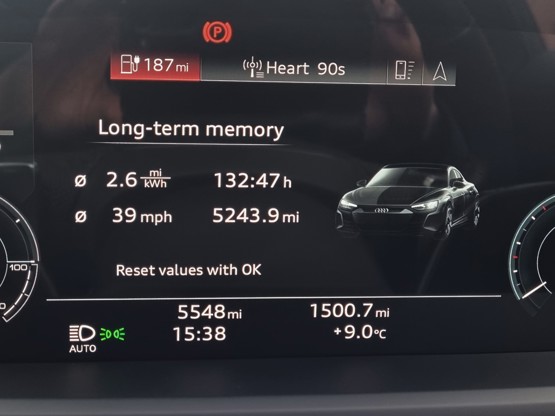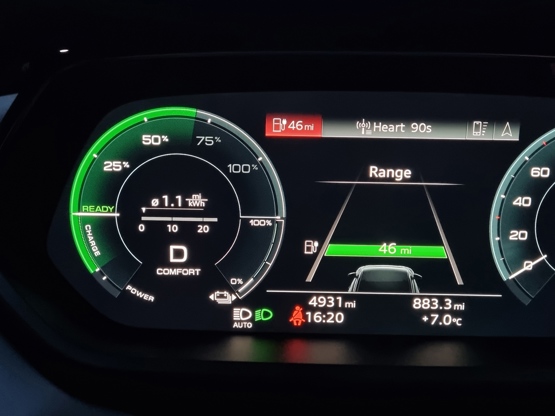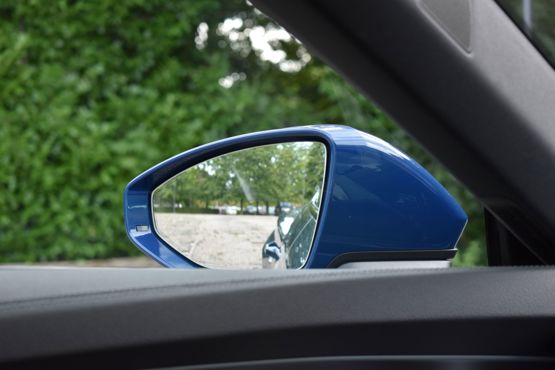Review
I entered the six-month long-term test of our Audi e-tron GT with trepidation. It’s not the typical type of car we test on Fleet News, after all. When I first drove one, a couple of years ago, I pondered whether it was a “futuristic supercar or a sensible electric saloon”. The truth is, it’s both.
After six months, and around 5,000 miles, my trepidation has turned into admiration. The work Audi has done to make the e-tron GT a competent daily driver is outstanding. It’s a driver’s car, through-and-through. From the looks to the sound, the acceleration and the handling, there’s very little to criticise.
For company car drivers the package is particularly compelling. With benefit-in-kind tax of just 2%, the monthly tax savings are significant. That’s probably why the majority of e-tron GTs sold to date have gone to fleet customers.
I didn’t have many gripes with the car’s range either. It’s not as capable as some EVs on the market, admittedly, but I never really struggled. On the coldest days it managed 180-200 miles and in warmer conditions we were seeing around 230 miles, on average. The best I saw was 250.

Our final stats show an achieved 2.6mi/kWh. A lighter right foot would undoubtedly achieve more, but the e-tron GT is just too fun not to enjoy every now and again. Read on, below, to find out more about the car’s range and efficiency.
The car’s rapid charging capabilities were only put to the test a handful of times as the majority of trips I do were well within the car’s range. When it does come to charging, the e-tron GT is rather unique in having two charging ports. While you can’t connect to both at the same time, it does aid practicality. As does the storage compartment under the bonnet, which is where I chose to keep the charging cables.
Luggage space isn’t the best. It’s not actually a tiny boot, measuring 405 litres, its just a very narrow space, which limits how much you can fit in. A couple of suitcases is do-able, however.
But the e-tron GT isn’t built to be super-practical. It’s a grand tourer, designed to go far and fast with the least amount of discomfort for its occupants. And on that basis it’s truly exceptional.
Enhanced by sound
A great driving experience is the result of multiple factors all working together. It’s not just about how fast a car is in a straight line, how quickly it can go around a corner or how accurate the steering is. It’s about how the car makes you feel, how much it engages you and, ultimately, how much of a smile it can put on your face.
Electric cars are quite good at straight line speed. A few have also mastered the art of cornering. But quite often there’s one part of the driving experience that is missing. Noise.
There are many benefits to a quiet electric motor, when compared to a petrol or diesel engine, but in a car designed to be emotive, a lack of noise can dampen the experience.
Audi has come up with a solution. It’s the e-tron Sport Sound. A £500 optional feature that’s fitted to our e-tron GT. It’s not some gimmicky fake engine sound that’s meant to replicate a petrol engine, though. It’s more like a subtle hum that’s linked to your inputs, reacting to prods of the throttle and increasing in intensity as the car accelerates.
The sound is played into the car via speakers in the rear doors, but there’s also speakers mounted outside the car, so the system performs the necessary function of alerting pedestrians to the car’s presence. Unlike most electric cars, which only emit their noise when moving, the e-tron GT can be heard as soon as you press the start button.
I’ve never found the Audi’s soundtrack to be irritating or intrusive. It just quietly plays in the background. If you’re driving the car particularly sedately, then it’s almost inaudible. A bit like an engine would be. But, if you press on, it becomes more vocal and switching to the Dynamic drive mode boosts the volume further.
“In principle, the sound of a car has much in common with music,” said Rudolf Halbmeir. The Audi sound designer is a dedicated musician who writes songs in his spare time and plays all the instruments himself in his private recording studio.
Halbmeir explained: “To find the basis for the sound of the e-tron GT, I tried all sorts of instruments – from the violin to the electric guitar all the way to the didgeridoo, a wind instrument from Australia.
“But none of them were really suitable. Then I came across a piece of plastic pipe lying in the garden. I attached a fan at one end and listened to the sound coming out the other end. It was a very specific, deep growl – and I knew straight away that I had discovered the foundation of the sound.”
The sounds emitted in the Audi’s cabin are a concoction of 32 synthesised sounds, which include recordings of a cordless screwdriver and a model helicopter. They are continuously recreated as the algorithm mixes and prioritises the individual sounds differently as you drive.
It creates that all-important link between the car’s powertrain and your ears, adding theatre to the acceleration and enhancing the visceral experience.
Of course, if the Audi’s synthesised sound isn’t to your taste you can always turn up the volume on the 16-speaker Bang and Olusfen sound system instead.
How far can it go?
The Audi e-tron GT has an official WLTP range of around 300 miles. The specific figure depends on the car’s exact specification, but it’s a close enough benchmark.
Like most electric vehicles (EVs) we test, achieving the claimed range in the e-tron GT has not been possible so far.
That’s not to say it has been performing poorly, however. In the warmer months, when we took delivery of the car, it was predicting 255 miles per charge. I’d never risk taking it all the way to zero – so let’s say an actual achievement of around 235 miles is a more realistic figure. For me, this has been an ample range. I've only been on two trips in the last four months that have required some extra charge to get me home.
As temperatures dropped, my promised range from a full battery has fallen to around 200 miles, according to the car’s estimations. I’d call that 180 to be safe.
What really matters is how much electricity the car is using to cover those miles.
Electricity prices are still rising and focusing on a car’s headline range figure only tells half the story. An efficient EV with a small battery will cost less to travel a set distance than an inefficient one with a large battery.
The e-tron GT Quattro is fitted with a 93kWh battery, of which 83.7kWh is ‘useable’. That means, at the current domestic electricity price cap rate (30p per kWh), a full charge at home will cost £25.
In the summer, the car uses 1kWh of energy to travel three miles (3.0mi/kWh), meaning that my £25 charge equates to a cost of around 10p per mile. In the winter, the e-tron GT is averaging 2.4mi/kWh, so my electricity cost increases to 12p per mile.
If I use a public rapid charger, the cost per mile increases quite significantly, but you can add more than 100 miles worth of range in about 10 minutes, thanks to the car’s 270kW DC charging capability.
While these running costs are still impressively low for a high-performance car, we have to consider that if the e-tron GT were more efficient it’s running costs would be even more compelling. Especially when charging away from home.
For example, if it could match the BMW i4 eDrive40’s 4.0mi/kWh, the electricity cost would fall to just 7p per mile and I’d be able to cover an additional 80 miles between charges. A rapid charge (adding 100 miles) would also cost about £6 less.
I was hoping the e-tron GT would be capable of slightly better efficiency. After all, it does have a low, sleek body and a clever gearbox that can detach the rear electric motor when you’re cruising.
Looking back at some of the other EVs we’ve tested – BMW i5 M60 (2.9mi/kWh) and Jaguar I-Pace (2.7mi/kWh) – suggests the e-tron GT’s efficiency is on par with its competition.
One thing I have noticed as the weather has gotten colder is the e-tron GT restricts how much power you can access when the battery charge drops below 25%. It’s normal for an EV to reign itself in when the range reaches a critical level, but the Audi is restricting me to around 70% power when there’s still 50 miles remaining. The reduction is quite noticeable and a little frustrating.

Pricing justified
It used to be the case that long-range electric cars carried the biggest price tags and if you wanted something that could manage even 200 miles on a charge then you’d be looking at a top-end premium model.
Things have changed quite rapidly, however, and now its quite easy to find an affordable model with a 250-to-300-mile range.
Premium brands then started chasing performance. Acceleration times once reserved for supercars were now being offered in saloons and SUVs. Once again, the mainstream brands have since played catch-up and even the likes of Kia will now sell you an EV than can outpace a Ferrari from the traffic lights.
So, what do you get for your money if you opt for a big-ticket EV over a cheaper one? Our Audi e-tron GT comes in at a little over £90,000, can cover between 210 and 250 miles per charge and can hit 60mph from rest in about four seconds.

On paper these stats aren’t particularly ground-breaking. I recently tested the MG 4 XPower, which is more practical than the Audi, costs less than £40,000 and manages to out-accelerate it too.
Aside from the obvious visual differences, once you drive an e-tron GT you quickly realise that it’s no ordinary car and is, in fact, quite special. The engineering that has gone in to developing the car makes it one of the very best EVs to drive. It’s superbly balanced with forgiving suspension that keeps the car’s 2.5-tonne heft in check but also provides a supple ride.
When you apply throttle in the e-tron GT it accelerates effortlessly and confidently. There’s no wheel-slip as the twin-motor powertrain utilises Quattro all-wheel-drive to slingshot you forwards. On dry or wet roads the car is sure-footed and able to deploy its power when needed.
Its slick body produces very little wind noise and with a wide track, the car’s stability is never in question. When you reach a corner, the steering is nicely weighted and feels direct. With little body roll the car changes direction in a fluid manner, just as you’d expect from a vehicle with sports car DNA.
When I switched back into the MG 4 XPower I was quickly reminded why the Audi commands a higher price tag. Impressive as the MG’s power output may be, it simply is pointless in a car that doesn’t have a sufficient chassis to harness such might. Floor the MG and it's left scrabbling for grip. Meet a corner and its suspension will not enable entry or exit speeds anywhere close to the Audi. When it comes to braking and steering, the confidence the e-Tron GT provides is not as prevalent in the XPower.
So, the Audi e-tron GT isn’t particularly cheap, doesn’t have a market-leading range and isn’t the fastest accelerating car on sale. But, if you factor in driver engagement, handling and real-world performance, it’s one of the very best.
Trepidation unwarranted
I’m not going to lie, in the final weeks before the e-tron GT was delivered I was feeling a slight degree of trepidation about living with it. It’s undeniably an exciting prospect, but faced with having to manoeuvre it day-to-day, park it in public car parks and accept the very real possibility that – with an almost six-figure price tag - it could be a target for thieves, my enthusiasm was diminished.
Having driven an e-tron GT before, I knew the car’s sheer width, combined with its low-slung driving position and small windows meant the chances of kerbing those 20-inch wheels or scuffing those beautifully sculpted bumpers was quite high.
Of course, having clocked up 2,000 miles in the car thus far and acclimatising to it fully, I now realise that my fears were unwarranted. Certainly, the first time you get in an e-tron GT, you’ll be aware that this is no normal saloon. It has the look and feel of a sportscar, which also includes some of the impracticalities.
The doors are small and the roof is low, so getting in and out is a little tricky. The long, wide bonnet curves away from the driver, disappearing from view. The rear view mirrors are filled with the view of those rear haunches. Thankfully, our car is equipped with all-around parking sensors and a 360-degree camera system.

In reality, the car’s footprint is about the same as an A7. Once you overcome the visibility issues it’s as easy to live with as any other saloon car.
The frightening pace provided by the two electric motors never becomes tiresome. It pushes out 476PS day-to-day, while a Boost function delivers up to 530PS. Audi has done excellent work in calibrating the throttle pedal so the power reserves never catch you out. The pedal is progressive, with long travel, and easy to modulate.
As we round of our second month of living with the e-tron GT I’m still getting to grips with how far it can go on a charge. At 100% the car suggests 250 miles is possible and we’ve been able to achieve 3.0mi/kWh on longer trips, suggesting that’s an accurate prediction. I’ve yet to run the battery flat, however. The most I’ve managed is 220 miles, after which the car suggested 18 miles of continued driving was possible.
Audi e-tron GT Quattro joins our fleet
Usually, when we start these long-term test reports we’ll give you a brief summary of what the car is and what segment it competes in. But, in the case of the Audi e-tron GT, it’s hard to pinpoint exactly what it is.
It’s built alongside the Audi R8, so is it a super car? It’s got four-doors and a boot, so it must be a saloon, right? Look at that sloping roofline and the low-slung driving position. Whatever it is, it’s eye-catching.
Audi calls it a GT – or Grand Tourer. For all intents and purposes, though, the e-tron GT is a sports car.
A sports car. In Fleet News? Well, this is an electric sports car. So, while it may be the most stand-out thing in the car park, it’s still a relatively sensible zero-emission vehicle that attracts less benefit-in-kind tax than a Skoda Fabia.

Of course, we’re not suggesting that the e-tron GT is going be a suitable replacement for a driver in Ford Focus. But, there’s plenty of drivers in higher-end cars, that are probably powered by massive, dirty petrol and diesel engines, costing them a fortune in tax, that could find the Audi remarkably appealing.
Let’s talk numbers. Our car comes in at a shade over £90,000. It’s a e-tron GT Quattro, which is basically the entry-level model. Although there’s only two to choose.
It’s equipped with Audi’s Technology Pack, costing £3,195, which includes a Bang & Olufsen audio system, ambient lighting and a 360-degree camera with remote parking assist. There’s also Ascari Blue paint (£950) and e-tron Sport Sound (£500), taking the car above its base price of £86,135.
As standard the car comes with 20-inch alloy wheels, keyless entry, an electric tailgate, LED headlights, heated front seats, leather upholstery, three-zone climate control and Audi’s MMI infotainment system with a ‘virtual cockpit’ digital instrument cluster.
One box we forgot to tick was the Tour Pack. This £1,335 option is, essentially, adaptive cruise control. Without it the e-tron GT just comes with standard cruise. To be honest, I was a little surprised at this as even a base-spec VW Golf comes with adaptive cruise as standard.






























